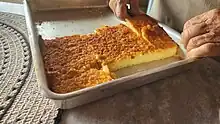 Homemade mané pelado | |
| Type | Cake |
|---|---|
| Place of origin | Brazil |
| Region or state | Goiás |
| Main ingredients | Yuca, cheese, shredded coconut |
Mané pelado (Portuguese: [mɐˈnɛ peˈladu] ⓘ; lit. 'Naked Mané') or bolo mané pelado is a Brazilian cake very traditional to Goiás and the Center-West.[1][2] It consists of shredded yuca and coconut, and a salty cheese such as canastra cheese or minas cheese.[2][3] It can be found at regional Festa Juninas in Brazil.[3]
History
While the exact history of this cake is unknown, there are two legends that explain its origin. One legend tells that this cake was invented by a resident of Goiás who had her husband Manuel, or Manoel, sell it on the streets. Manuel, or Mané for short, would sell this cake while shirtless due to the intense heat of the cerrado. Due to this, the mandioca cake he sold came to be known as bolo do mané pelado (Portuguese: Naked Mané's cake) and ultimately mané pelado.[2] Another legend states that the dessert was named in honor of a farmer named Mané who harvested yuca while naked.[1][3][4]
See also
References
- 1 2 Ledur, Júlia. "De cueca virada a mané pelado: 13 comidas com nomes curiosos". Gazeta do Povo (in Brazilian Portuguese). Retrieved 2023-09-06.
- 1 2 3 CyberCook (2021-09-12). "Mané pelado, o apelido que virou o icônico bolo goiano". Blog CyberCook (in Brazilian Portuguese). Retrieved 2023-09-09.
- 1 2 3 Rossi, Mariane (2022-06-24). "'Mané pelado' é o típico bolo de mandioca ralada, que fica cremoso e perfeito para a festa junina; aprenda". G1 (in Brazilian Portuguese). Retrieved 2023-09-09.
- ↑ Oliveira Santos, Thiara Augusta (2023-02-13). "Projeto Lendas: Mané Pelado". Territórios Gastronômicos (in Brazilian Portuguese). Retrieved 2023-09-06.